[press release]
Royal Mail Heritage: Transport
Issue Date: Wednesday 17th February 2016
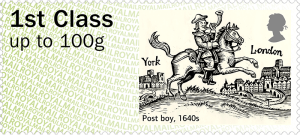 PRODUCT RANGE AT A GLANCE
PRODUCT RANGE AT A GLANCE
- 6 * 1st Class stamp set with carrier
- First Day Cover
- First Day Envelope (New Generic version)
REASON & INSPIRATION
The Royal Mail Heritage: Transport set of stamps reflects the movement of mail via methods of transport. The earliest method of transport for mail was by foot, but increased distance and a greater volume of letters led to the employment of horses. Even greater volumes of mail entailed the use of horse-drawn carts and then vans for road transport, as well as the early adoption of railways, while sailing ships carried the mail still farther, 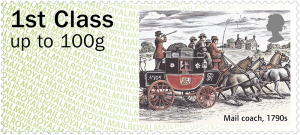 across the globe. These have been the favoured forms of mail transport for much of the past five centuries.In the 19th century, inviting contractors to tender for mail routes proved very effective, and they provided the transport and drivers that operated to strict demands of time. The availability of fairly reliable second-hand vehicles following the First World War pushed forward the creation of state-owned fleets, while advances in air travel meant that letters and parcels could be delivered even faster. Today, mail continues to be carried throughout the day and night by land, sea and air.
across the globe. These have been the favoured forms of mail transport for much of the past five centuries.In the 19th century, inviting contractors to tender for mail routes proved very effective, and they provided the transport and drivers that operated to strict demands of time. The availability of fairly reliable second-hand vehicles following the First World War pushed forward the creation of state-owned fleets, while advances in air travel meant that letters and parcels could be delivered even faster. Today, mail continues to be carried throughout the day and night by land, sea and air.
PRODUCTS IN DETAIL Stamp Set with Carrier Card
Price: £3.78 Code: ZS042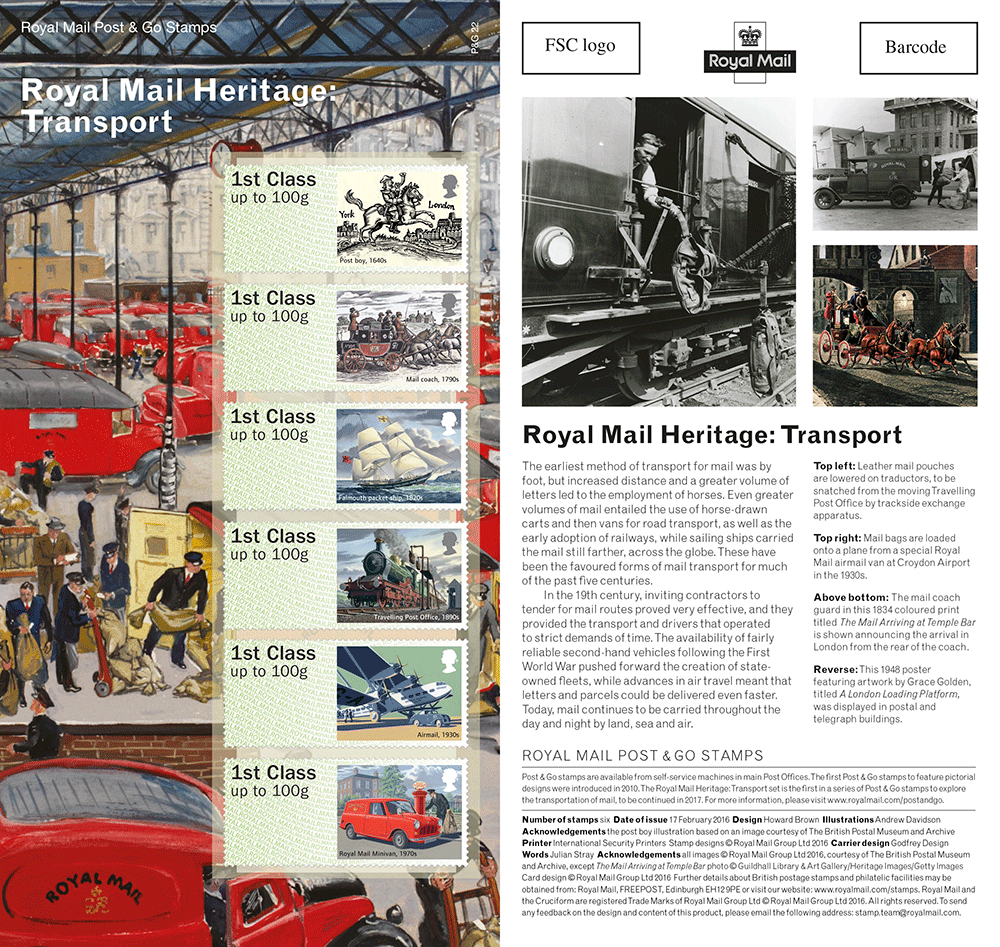
First Day Cover Inland (Tallents House Handstamp)
Price: £5.02 Code: ZF022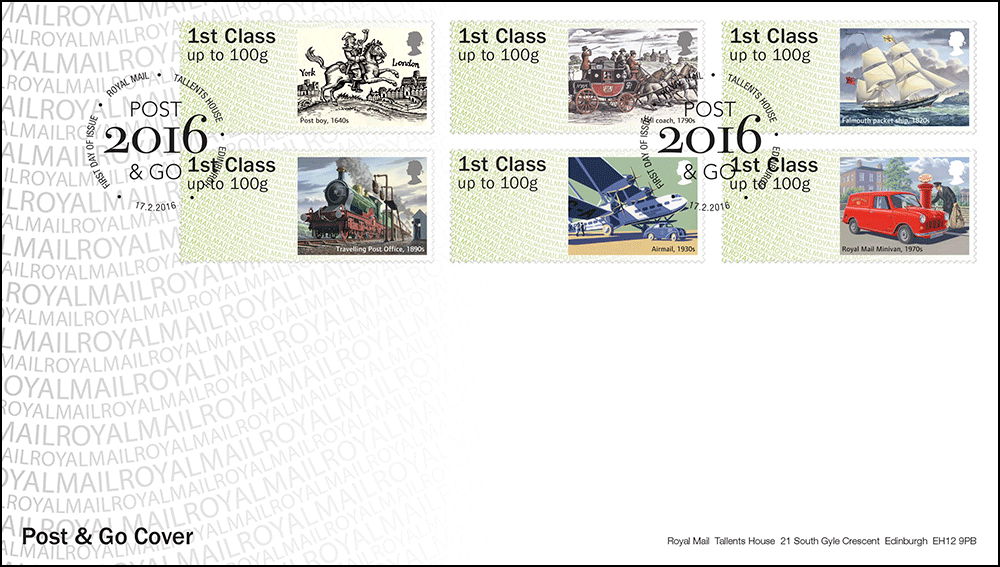
First Day Cover Inland (Alternative Handstamp)
Price: £5.02 Code: ZF022
The alternative handstamp location Letters, Gavre has been chosen based on its name.
Filler Card
Price: 30p Code: ZE020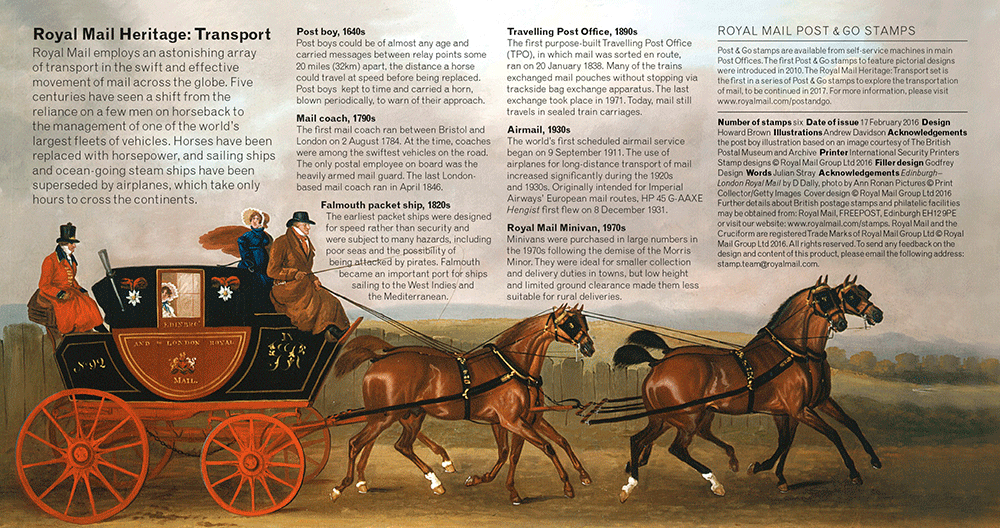
STAMP SPECIFICATIONS
Post & Go Stamps Royal Mail Heritage: Transport
- Number of stamps: Six
- Date of issue: 17th February 2016
- Design: Howard Brown
- Illustrations: Andrew Davidson
- Acknowledgements: The Post boy illustration based on an image courtesy of The British Postal Museum and Archive.
Carrier design Godfrey Design Words Julian Stray Acknowledgements all images © Royal Mail Group Ltd 2016, courtesy of The British Postal Museum and Archive, except The Mail Arriving at Temple Bar photo © Guildhall Library & Art Gallery/Heritage Images/Getty Images Card design © Royal Mail Group Ltd 2016 - Printer: International Security Printers
- Process: Gravure
- Format: Landscape
- Size: 56mm x 25mm
- Perforations: Die-cut simulated
- Phosphor: Bars as appropriate
- Gum: Self-adhesive
Value/Description
 As overprinted by Post & Go machine: Post boy, 1640s. Post boys could be of almost any age and carried messages between relay points some 20 miles (32km) apart, the distance a horse could travel at speed before being replaced. Post boys kept to time and carried a horn, blown periodically, to warn of their approach.
As overprinted by Post & Go machine: Post boy, 1640s. Post boys could be of almost any age and carried messages between relay points some 20 miles (32km) apart, the distance a horse could travel at speed before being replaced. Post boys kept to time and carried a horn, blown periodically, to warn of their approach.
 As overprinted by Post & Go machine: Mail coach, 1790s. The first mail coach ran between Bristol and London on 2 August 1784. At the time, coaches were among the swiftest vehicles on the road. The only postal employee on board was the heavily armed mail guard. The last London-based mail coach ran in April 1846.
As overprinted by Post & Go machine: Mail coach, 1790s. The first mail coach ran between Bristol and London on 2 August 1784. At the time, coaches were among the swiftest vehicles on the road. The only postal employee on board was the heavily armed mail guard. The last London-based mail coach ran in April 1846.
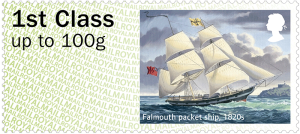 As overprinted by Post & Go machine: Falmouth packet ship, 1820s. The earliest packet ships were designed for speed rather than security and were subject to many hazards, including poor seas and the possibility of being attacked by pirates. Falmouth became an important port for ships sailing to the West Indies and the Mediterranean.
As overprinted by Post & Go machine: Falmouth packet ship, 1820s. The earliest packet ships were designed for speed rather than security and were subject to many hazards, including poor seas and the possibility of being attacked by pirates. Falmouth became an important port for ships sailing to the West Indies and the Mediterranean.
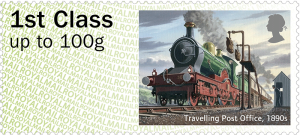 As overprinted by Post & Go machine: Travelling Post Office, 1890s . The first purpose-built Travelling Post Office (TPO), in which mail was sorted en route, ran on 20 January 1838. Many of the trains exchanged mail pouches without stopping via trackside bag exchange apparatus. The last exchange took place in 1971. Today, mail still travels in sealed train carriages.
As overprinted by Post & Go machine: Travelling Post Office, 1890s . The first purpose-built Travelling Post Office (TPO), in which mail was sorted en route, ran on 20 January 1838. Many of the trains exchanged mail pouches without stopping via trackside bag exchange apparatus. The last exchange took place in 1971. Today, mail still travels in sealed train carriages.
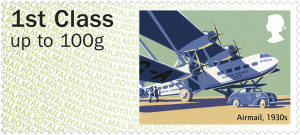 As overprinted by Post & Go machine: Airmail, 1930s. The world’s first scheduled airmail service began on 9 September 1911. The use of airplanes for long-distance transport of mail increased significantly during the 1920s and 1930s. Originally intended for Imperial Airways’ European mail routes, HP 45 G-AAXE Hengist first flew on 8 December 1931.
As overprinted by Post & Go machine: Airmail, 1930s. The world’s first scheduled airmail service began on 9 September 1911. The use of airplanes for long-distance transport of mail increased significantly during the 1920s and 1930s. Originally intended for Imperial Airways’ European mail routes, HP 45 G-AAXE Hengist first flew on 8 December 1931.
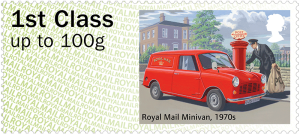 As overprinted by Post & Go machine: Royal Mail Minivan, 1970s. Minivans were purchased in large numbers in the 1970s following the demise of the Morris Minor. They were ideal for smaller collection and delivery duties in towns, but low height and limited ground clearance made them less suitable for rural deliveries.
As overprinted by Post & Go machine: Royal Mail Minivan, 1970s. Minivans were purchased in large numbers in the 1970s following the demise of the Morris Minor. They were ideal for smaller collection and delivery duties in towns, but low height and limited ground clearance made them less suitable for rural deliveries.
ROYAL MAIL POST & GO STAMPS
Post & Go stamps are available from self-service machines in main Post Offices. The first Post & Go stamps to feature pictorial designs were introduced in 2010. The Royal Mail Heritage: Transport set is the first in a series of Post & Go stamps to explore the transportation of mail, to be continued in 2017. For more information, please visit www.royalmail.com/postandgo.
- Number of stamps six
- Date of issue 17 February 2016
- Design Howard Brown
- Illustrations Andrew Davidson
- Acknowledgements the post boy illustration based on an image courtesy of The British Postal Museum and Archive Printer International Security Printers Stamp designs © Royal Mail Group Ltd 2016 Carrier design Godfrey Design Words Julian Stray Acknowledgements all images © Royal Mail Group Ltd 2016, courtesy of The British Postal Museum and Archive, except The Mail Arriving at Temple Bar photo © Guildhall Library & Art Gallery/Heritage Images/Getty Images Card design © Royal Mail Group Ltd 2016

Further details about British postage stamps and philatelic facilities may be obtained from: Royal Mail, FREEPOST, Edinburgh EH12 9PE or visit our website: www.royalmail.com/stamps. Royal Mail and the Cruciform are registered Trade Marks of Royal Mail Group Ltd © Royal Mail Group Ltd 2016. All rights reserved.
To send any feedback on the design and content of this product, please email the following address: stamp.team@royalmail.com.



